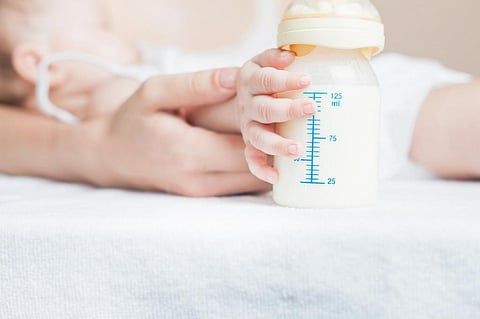

Despite the use of bisphenol-A (BPA) being prohibited in feeding bottles for babies, the toxic chemical continues to be found in some bottles and cups for babies sold in the Indian market, and is leaching into baby foods, found a recent study conducted by Toxics Link.
BPA is an endocrine-disrupting chemical that has been accepted as the “chemical of concern” globally, and countries have taken action to phase it out from products. The toxic chemical is known to mimic a hormone in the body which activates the progression of cancer and interferes with the development of the reproductive system.
Epidemiological studies of children indicate correlations between BPA exposure and heart diseases, liver toxicity, and metabolic syndrome (diabetes obesity). As per the current Bureau of Indian Standard (BIS) regulations, the use of BPA is prohibited, but the current study observed the migration of BPA in baby feeding bottle samples.
A set of 20 samples of baby feeding bottles and sippy cups were randomly collected from eight states: Gujarat, Rajasthan, Kerala, Andhra Pradesh, Jharkhand, Maharashtra, Manipur and Delhi. The samples were sent to the Indian Institute of Technology, Guwahati, for the study titled Bottles can be Toxic- Part II.
The collected samples included both branded and local feeding bottles as well as sippy cups of different brands. Ten (seven bottles and three sippy cups) of them were labelled ‘BPA-free’ or zero per cent BPA.
It was observed that all 20 samples showed release of BPA between 0.9 ppb and 10.5 ppb (parts per billion) in its first extraction and 0.008 ppb and 3.46 ppb in second extraction from the same containers (migration was analysed two times).
Only one sample of baby feeding bottles showed no level of BPA migration in its second extraction; the same sample showed the lowest concentration in the first extraction.
The results suggest that there is a chance that the containers have more BPA. In the earlier studies, the total BPA level was detected between 0.1 and 98.4 ppm (parts per million) in baby feeding bottle, while in sippy cups it was detected between below detectable level to 14.9 ppm.
“Earlier the baby feeding bottles and sippy cups were manufactured with polycarbonate in which BPA was the main constituent (BPA is the building block for polycarbonate). However, after the prohibition of BPA, it is quite surprising that traces of BPA are still being found in the bottles. Similarly, traces of BPA were also detected in the sippy cups. Hence, it raises questions on the material being used in baby feeding bottles and sippy cups,” said the study.
Toxics Link had undertaken the first study in India in 2014 on the presence of BPA in baby feeding bottles, and found high presence of BPA in the samples tested. Subsequently BIS revised the standard for baby feeding bottles in 2015 as per IS 14625:2015, and prohibited the use of BPA in baby feeding bottles.
Further, the Ministry of Women and Child Development had said that the material used for plastic feeding bottles and accessories, excluding teats, shall be of polypropylene conforming to IS 10910 or polyethersulfone (PES) or any other olefin based polymer, co-polyester material or other raw material. The materials used should not pose any health risk to babies and shall not contain BPA.
“The polycarbonate-based baby feeding bottles are still available in the Indian market, even though they have been prohibited since 2015 as per BIS. Hence, it needs stricter monitoring,” said Prashant Rajankar, programme coordinator at Toxics Link.